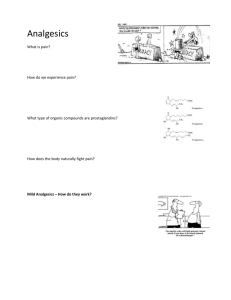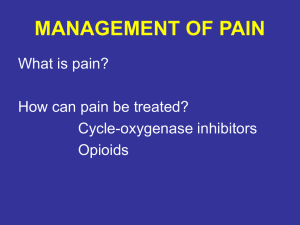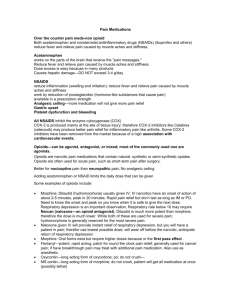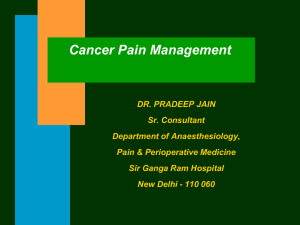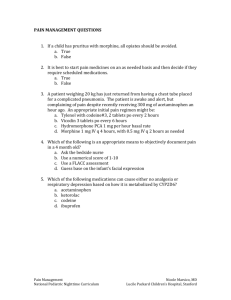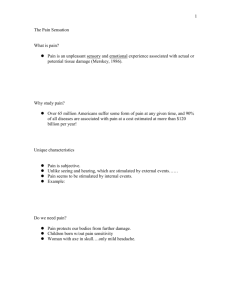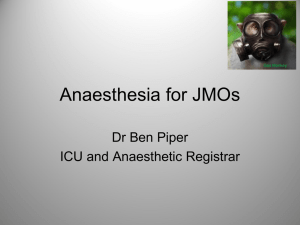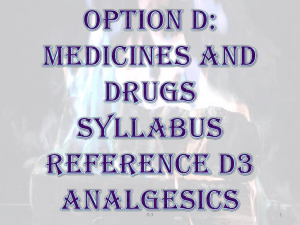Analgesics(morphine)
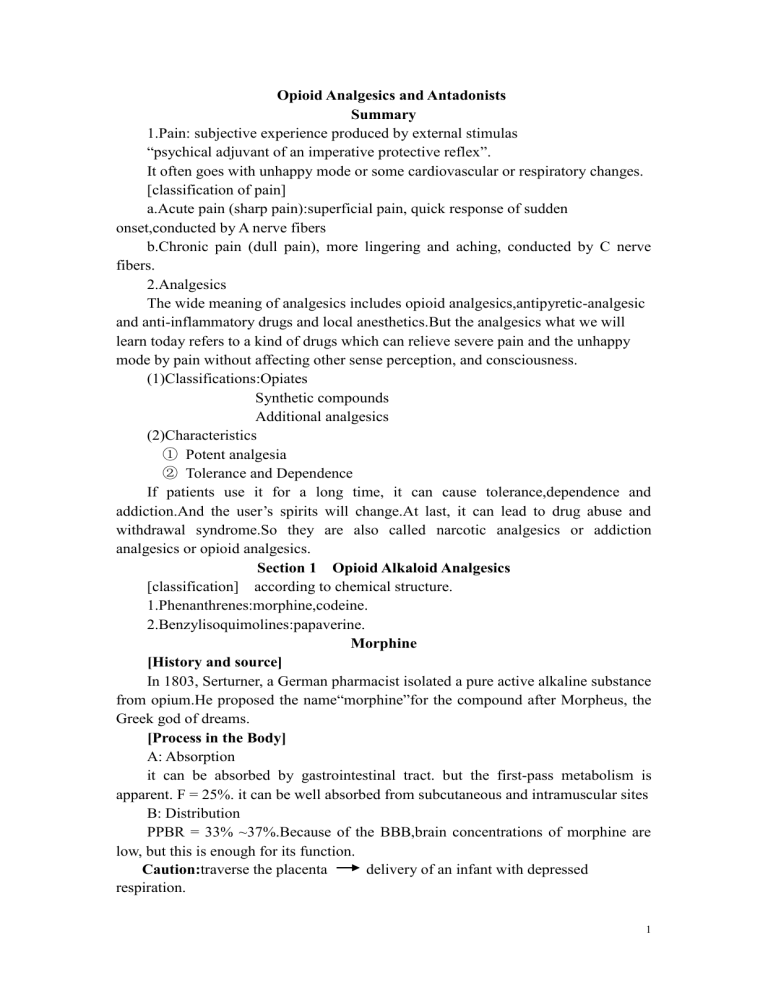
Opioid Analgesics and Antadonists
Summary
1.Pain: subjective experience produced by external stimulas
“psychical adjuvant of an imperative protective reflex”.
It often goes with unhappy mode or some cardiovascular or respiratory changes.
[classification of pain] a.Acute pain (sharp pain):superficial pain, quick response of sudden onset,conducted by A nerve fibers b.Chronic pain (dull pain), more lingering and aching, conducted by C nerve fibers.
2.Analgesics
The wide meaning of analgesics includes opioid analgesics,antipyretic-analgesic and anti-inflammatory drugs and local anesthetics.But the analgesics what we will learn today refers to a kind of drugs which can relieve severe pain and the unhappy mode by pain without affecting other sense perception, and consciousness.
(1)Classifications:Opiates
Synthetic compounds
Additional analgesics
(2)Characteristics
① Potent analgesia
② Tolerance and Dependence
If patients use it for a long time, it can cause tolerance,dependence and addiction.And the user’s spirits will change.At last, it can lead to drug abuse and withdrawal syndrome.So they are also called narcotic analgesics or addiction analgesics or opioid analgesics.
Section 1 Opioid Alkaloid Analgesics
[classification] according to chemical structure.
1.Phenanthrenes:morphine,codeine.
2.Benzylisoquimolines:papaverine.
Morphine
[History and source]
In 1803, Serturner, a German pharmacist isolated a pure active alkaline substance from opium.He proposed the name“morphine”for the compound after Morpheus, the
Greek god of dreams.
[Process in the Body]
A: Absorption it can be absorbed by gastrointestinal tract. but the first-pass metabolism is apparent. F = 25%. it can be well absorbed from subcutaneous and intramuscular sites
B: Distribution
PPBR = 33% ~37%.Because of the BBB,brain concentrations of morphine are low, but this is enough for its function.
Caution: traverse the placenta delivery of an infant with depressed respiration.
1
C: Metablism
It is metablized in the liver.
D:Excretion excreted mainly through the kidney. Breast milk can excret a small part of them.
It can also come into infants body through placenta.t
1/2
is 2~3hours.
[Pharmacological Effects]
1.CNS effects :principal effects.
Include analgesia,euphoria,sedation,and respiratory depression.With repeated use,a high degree of tolerance occurs to all of these effects.
(1)Analegesia :
Morphine has a good effect on all kinds of pain.
1)Stronger and longer
Transdermal administration of morphine 5-10mg can relieve or decrease pain apparently. Its effect can last 4-6 hours.
2)More effective in continuous dull pain than sharp intermittent pain.
3)Analgesia without the loss of consiousness and no effects on other senses.
4)Euphoria:pain still present,but produces a powerful sense of contentment and well-being (caused by stimulation of the ventral tegmentum).
(2)Sedation : Morphine can change the patient’s mode, calm people who are anxious, nervous or scared due to pain and increase people’s tolerance to pain.
(3)Respiratory depression :
Therapeutic dose can depress respiration the frequency of breath.In toxicosis the frequency will decrease to 3-4 per minute.
[mechanisms of Respiratory depression]
1.inhibits brain stem respiratory center
2.decrease the sensitivity of respiratory center to carbon dioxide challenge in blood.
The respiratory depression is dose-related.If it is used with anesthesia and alcohol, the respiratory depression will aggravate.
(4)Cough suppression :Through inhibiting cough center directly,morphine makes the reflex of cough disappear.
(5)Others : a.miosis
:due to excitatory action on the Edinger-Westphal nucleus of the oculomotor nerve.
Needle-like(pinpoint) pupils are the characteristic in acute poisoning.
This is important diagnostically, because most other causes of respiratory depression produce dilation of pupil. b.Emesis
:Morphine can activate the brain stem chemoreceptor trigger zone to produce nausea and vomiting. c.Hormone actions
↓ release of gonadotropin-releasing hormone (GnRH)
↓ release of corticotropin-releasing hormone(CRF)
↓ concentration of luteinizing hormone (LH) ,follicle-stimulating hormone(FSH)
2
↓ adrenocorticotropic hormone(ACTH)
↑ prolactin release by diminishing DAergic inhibition.
2.Smooth mucle Stimulating
(1)GI:Constipation
(2)biliary tract : The sphincter of Oddi may constrict, resulting in the reflux of biliary and the increasing of its pressure. This may lead to biliary colic. Atropine can partly relief this feeling
(3)other smooth muscles: a.Urinary:increase the tension of ureteral smooth muscle and bladder sphincter,resulting in urinary retention. b.Bronchia:Therapeutic doses of morphine don’t activate bronchus smooth muscle,but large doses can constrict it,inducing or aggravating asthma.
3.Cardiovascular system
1)Direct vessel dilatation and induce releasing of histamine result in peripheral resistance reduction , BP ↓ .
2)Increase cerebrospinal fluid pressure due to CO2 retention cerebrovasodilation :
↓ Respiration, CO2 ↑ ,results in cerebrovasodilation and increase intracranial pressure.
Therfore,morphine is usually contraindicated in individuals with severe brain injury.
[Mechanisms of Action]
It mainly stimulates µ opiod receptor to exert the effect of analgesia.
[Clinical Use]
1.Analgesia
(1) morphine can relieve or demolish severe pain(such as the pain caused by trauma,burn),pain of terminal illness,and postoperation pain.
(2)In angina pectoris, it can relieve not only the anxiety and pain of patients but also decrease the load of heart through dialating blood vessels.
2.Cardiac asthma : Dyspnea from acute pulmonary edema caused by the acute left ventricular failure.
(1) Dilating the peripheral vessel to reduce the load of heart.
(2) Sedation
(3) Reduced perception of shortness of breath by ↓ sensitivity of CNS to CO2.
3.Diarrhea acute or chronic consuming diarrhea. use its compound medicine such as Opium Tincture and Tincture Camphor
Compound.If diarrhea is associated with bacteria infection ,we can use antibiotics at the same time
[Toxicity and Undesired Effects]
1.Common Side Effects
Therapeutic dose of morphine can cause dizziness,nausea, vomiting, constipation, hard breath,increasing pressure of biliary,even biliary colic and hypotension.
3
2.Tolerance and dependence,addiction and liability for abuse .
(1)The persisting use of morphine for 1-2 weeks may produce tolerance. them
(2)Dependence means after repeated use of such drugs ,users may be addict in
Euphoria addiction stop use abstinence syndrome compulsive drug-seeking behavior
Abstinence syndrome: diarrhea, vomiting, chills fever, lacrimation, rhinorrhea, tremor, abdominal cramps and pain.
“Administration Law for Narcotics” The Treatment of Addiction a.Withdraw the patient from drug b.Methadone maintenance c.Prevention of reuse:Opioid antagonists--naltrexone d.Psychological and other methods to society.
3.Acute toxicity
Respiratory inhibition deeply,coma,pine-point pupil is the character, blood pressure and temperature decrease, death due to respiratory paralysis. treatment: artificial respiration,O2,opioid receptor antagonists-naltrexone.
Contraindication: Newborn, infant, breasting period,patients with brain injures,patients with impaired pulmonary function,because it can cause acute respiratory failure,brain injury,patients with impaired hepatic or renal function
4
Codeine
The properties
1.Weaker analgesia,about 1/12 of morphine,used in moderate pain.
2.Central antitussives,used for suppressing cough.
Section 2 Artificial Synthetic Analgesics
Pethidine(Dolantin)
[Pharmacological properties]
1.CNS effects
Analgesia,sedation and respiratory depression are weaker and shorter than morphine.
No antitussive effects.
2.Smooth muscle system
Weaker than morphine,no antidiarrheal effects,may induce biliary colic, no antagonist effect of oxytocin.
3.Cardiovascular system: similar to morphine.
[Clinical Uses]
1.Severe pain
2.Cardiac asthma
3.Premedication in anesthesia and artificial hibernation.
[Adverse Reactions]
The side effects are similar to morphine.
Some Other Narcotic Analgesics
Methadone
Pharmacological properties similar to morphine, slow tolerance and addiction, abstinence light.
Used in severe pain and for detoxification and for maintenance of chronic replacing heroin addict.
Pentazocine
With moderate
and
agonism, weaker
antagonism, used in chronic severe pain, 1/3 analgesia of morphine and half respiratory inhibition of morphine. Almost no dependence.
Non-narcotic Analgesics
Rotundin
From traditional medicine Corydalis ambigua,moderate analgesia and sedation, duration of 2-5 hrs,used for chronic dull pain,visceral pain,headache and menstrual pain.
The Opioid Receptor Antagonists
Naloxone
Naltrexone
Competitive antagonize the
μδκ receptors
Uses
1.Antagonize the opiate poisoning.
2.Naltrexone is used to prevent relapse.
5
